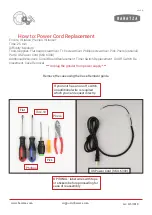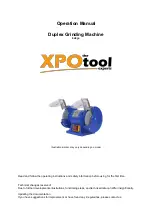
4
4) POWER TOOL USE AND CARE
1.
Do not force the power tool.
Use the correct power tool for your application. The
correct power tool will do the job better and safer at the rate which it was designed.
2.
Do not use the power tool if the switch does not turn it on and off.
Any power tool that
cannot be controlled with the switch is dangerous and must be repaired.
3.
Disconnect the plug from the power source before making any adjustments,
changing accessories, or storing power tools.
Such preventive safety measures
reduce the risk of starting the power tool accidentally.
4.
Store idle tools out of the reach of children and do not allow persons unfamiliar with
the power tool or these instructions to operate the power tool.
Power tools are
dangerous in the hands of untrained users.
5.
Maintain power tools
. Check for misalignment or binding of moving parts, breakage
of parts and any other condition that may affect the power tools operation. If
damaged, have the power tool repaired before use. Many accidents are caused
by poorly maintained power tools.
6.
Keep cutting tools sharp and clean.
Poorly maintained cutting tools with sharp
cutting edges are less likely to bind and are easier to control.
7.
Use the power tool, accessories and tool bits etc., in accordance with these
instructions and in the manner intended for the particular type of power tool, taking
into account the working conditions and the work to be performed
. Use of the power
tool for operations different from intended could result in a hazardous situation.
5) SERVICE
1.
Have your power tool serviced by a qualified service personnel using only identical
replacement parts.
This will ensure that the safety of the power tool is maintained.
ANGLE GRINDER SAFETY INSTRUCTIONS
1.
Before starting work, always consider the following:
The use of hand held angle
grinders for grinding and cutting operations can present risks to the user. Full
observation of the safety instructions in this user guide is essential.
2.
Before undertaking grinding or cutting operations, always consider the following:
Is
the grinding/cutting work necessary? Could a different tool be used with less risk?
(e.g. a fixed controlled cutting/grinding machine). Can the work be sensibly
positioned, secured and accessed so the operator can maintain adequate control
of the tool, taking into account, for example the possible hazards associated with
potential snatch/jamming of a cutting disc. Is the cutting task too large for a hand
held tool? If in doubt, use an alternative lower risk solution or refer to qualified trade
personnel.
3.
Always use the correct tool for the job.
Always assess the job. You should never force
a small angle grinder to do the job of a heavy tool. Do not use tools for purposes not
intended.
4.
Store power tools properly when not in use.
Abrasive products should be stored in a
dry, secure place out of the reach of children.





































